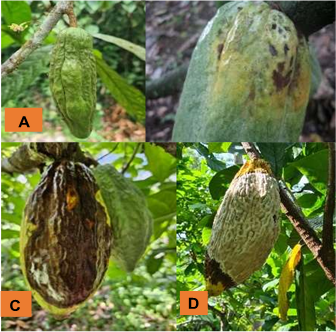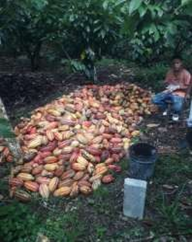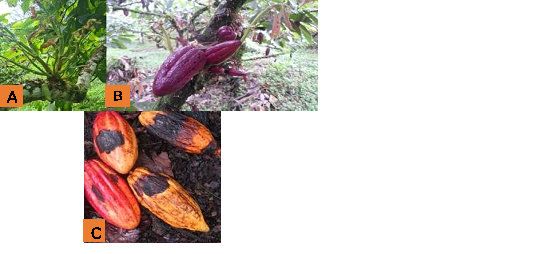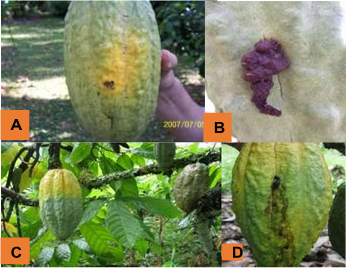eISSN: 2576-4462


Research Article Volume 8 Issue 4
Agronomist engineer, Private advisor. Medellin, Colombia
Correspondence: Gabriel Cubillos, Agronomist engineer, Private advisor. Medellin, Colombia
Received: December 18, 2024 | Published: December 30, 2024
Citation: Cubillos G. Main diseases and pests of cocoa in Colombia. Horticult Int J. 2024;8(4):123-128. DOI: 10.15406/hij.2024.08.00314
Yields of cocoa crops in Colombia have been threatened by the presence of diseases and pests, among which it is necessary to mention in order of importance Cacao frosty pod rot, Witches' broom, Black pod and Stem canker, Rosellinia and the Pod borer. Their incidence varies according to the climate and management operations of these phytosanitary factors.
It is currently and clearly established that Cocoa frosty pod rot and Witches' broom are effectively controlled by cultural practices, while for Black pod and Stem canker a combination of cultural practices with chemical control is done. Regarding the control of Rosellinia, an effective and economic control mechanism has not been found that would allow it to be recommended. The damage caused by the Pod borer is irrelevant to chemical control.
Keywords: Cocoa, fungal diseases, pests
Phytosanitary factors have been responsible for the low yields of cocoa crops in Colombia, especially fungal diseases. Most of them are found in all production areas, significantly affecting the income of producers. In the case of pests or insects, the situation is less serious because there are few species that threaten the crop. Consequently, it is essential to socialize the current information on these problems so that with good management the confidence of growers and entrepreneurs in this valuable raw material of the rural sector can be recovered.
The main diseases affecting cocoa in Colombia are Cocoa frosty pod rot, Witches’ broom, Black spot and Stem canker and, finally, Rosellinia or Star root decay. Among the pests, the only one that deserves special attention is the Cocoa pod borer due to the damage it causes to crops and quality of the cocoa beans.
Cacao frosty pod rotIt is a disease exclusive to the fruit. Caused by the fungus scientifically called Moniliophthora roreri (Cif. & Par.) Evans et al. are present in the main grow areas affecting yields between 30-80% and grain quality (Figure 1).
According to bibliographic information, Cocoa frosty pod rot, also known as Monilia, Moniliasis or Mancha in Spanish, was recorded in Colombia at the end of 1851 to the east and north of the Cauca River in the municipalities of Sopetrán and Santafé de Antioquia (department of Antioquia).
Symptoms and cycle of the diseaseThe first symptoms appear 30 days after infection. In fruits less than three months old, the symptoms are shiny bellies or swellings. In fruits older than three months, the symptoms are tiny oily spots under the epidermis accompanied by premature yellowing. After two months, the brown or coffee-colored spot forms on both kinds of fruit. 7 to 9 days later, the filamentous structure of the fungus forms and quickly becomes covered with cream-colored spores (Figure 2). Thus, the disease cycle is a little less than two and a half months.1

Figure 2 A, Young fruit (cherelle) with bellies or humps. B, fruit more ager with oily spots under the epidermis. C, fruit with brown spot. D, fruit in sporulation stage.
Newly sporulated (powdery) fruits hanging on the tree retain the potential for infection for three weeks (Figure 3). After that time, the sporulated fruits degrade and lose their potential for infection. In the end, they mummify but remain active at minimal levels due to their low infection capacity.
Green (cited by Merchán, 1981) showed that with an infection density of 3 sporulated fruits per tree, the incidence from the source of infection is 55% and 20 meters away from the same source the incidence drops to 10%.2 This indicates that the outbreaks of infection are due to the presence of high densities of sporulated fruits within the crop.
Cultural controlIt consists of rigorously removing from the stems and branches of trees the fruits that are in critical condition as sources of infection, such as sporulated fruits and those with symptoms of brown spots. At the beginning, this removal is done weekly for two and a half consecutive months, which corresponds to the end of the disease cycle period. From then on, the removal of diseased fruits is done at the same time as the harvesting of ripe fruits, normally every 2-3 weeks.3 The diseased fruits removed from the trees are left freely on the ground, since it has been duly proven that under these conditions the fruit decomposes rapidly and completely loses its capacity to infect.4
A practice that greatly facilitates the removal of diseased fruit is pruning because it allows viewing inside the tree canopy.
As a result of the cultural control of Cacao frosty pod rot, the case of the La ILusión farm, municipality of Chigorodó (department of Antioquia, Colombia) is mentioned, with a population of 800 cloned trees that recorded a production of 1,116-982 kilograms per hectare in the years 2022-2023 respectively with an incidence below 1.5% (Figure 4).

Figure 4 Harvest round with cultural control of Cocoa frosty pod rot. La ILusión farm, municipality of Chigorodó, department of Antioquia. Year 2023.
Originated by the fungus Moniliophthora perniciosa. It was first recorded in Colombia in the municipality of Tumaco, in 1925, introduced from Ecuador.
Symptoms and epidemiological aspectsIn vegetative shoots, hypertrophies with a diameter of 3-6 times that of the normal shoot are observed. In floral cushions, clusters of flowers and occasionally brooms of vegetative buds appear. The fruits that form on them are abnormal (“cherimoya” fruits). In older fruits, the symptom is a dark brown or black spot with a slightly circular shape and a hard consistency (Figure 5).

Figure 5 A, Witches' broom on vegetative shoots. B, Witches' broom on floral cushions. C, Witches' broom on older fruits.
After emergence, vegetative brooms remain green for 8 weeks and dry for 13 weeks, beginning the production of umbrellas (basidiocarps) where the pathogen spores are formed (Figure 6). Vegetative brooms can continue producing basidiocarps for 22 weeks according to the sequence of rainy and dry periods.5
Studies carried out by Rocha and Wheeler6 demonstrated that under balanced humidity and drought conditions the formation of primordia and maturation of umbrellas or basidiocarps is highly favored.
Fruits are an important source of infection because they produce larger and more abundant basidiocarps than vegetative brooms. They take 3 weeks to dry and more than 8 weeks to produce basidiocarps. They can continue producing basidiocarps for up to 24 months. Diseased trees are important as sources of infection up to a distance of 90 meters. However, the radius of action can extend up to 70-80 kilometers.
When the disease is very severe it can cause 40-45% damage to crops.
Cultural controlRemoval of shoots with brooms, cushion brooms and diseased fruits is the most effective and economical method of control. Diseased organs are removed from the trees and left freely on the ground to decompose naturally. Priority should be given to dry organs as they become sources of infection in the short time.
Pruning is usually used to remove diseased organs and after 6 months a second round is done to eliminate any new diseased organs that appear within the crop.
An example is the case of the Cacaoteras del Dique farm, in the municipality of Caucasia, Colombia, with a population of 150,000 15-year-old hybrid cacao trees, where the growth of the disease remained at a level of 0.5% after three and a half years of applying cultural control of the disease (years 1980-1983). However, in the last six months the growth in the number of affected trees stood in 0.04 per thousand.7
Black pod and Stem cankerIn Colombia, the species Phytophthora palmivora is the main pathogen causing Black pod and Stem canker. However, in Africa and America there are other species that cause them.
Globally, it is estimated that yield losses due to Black pod are in the order of 20-30% and trees death due to Stem canker can reach 10%.
Symptoms and epidemiological aspectsFruits in an advanced stage of development are the most susceptible to Black pod disease. Diseased fruits have a brown spot with well-defined edges. Within 4-5 days, a white filamentous structure forms on the brown spot, in which sporangia are produced, releasing the spores responsible for spreading the disease. Stems and branches with Stem canker show moist areas that secrete a red wine-colored liquid when scraped. The wood takes on a reddish color (Figure 7).
Spores are carried by rainwater splashes, water currents, wind and ants. They germinate under moist conditions.
Stem canker can cause the death of the tree when the lesion on the stem extends throughout its thickness (Figure 8).
Cultural and chemical controlRemoving diseased fruits and placing them in the center of the rows between cocoa trees is a recommended practice to eliminate direct sources of infection. The accumulation of fruit shells near trees should be avoided so that they do not serve as a source of infection. It is also advisable to remove the nets formed by ants on the stems and branches to prevent the role they play in spreading the disease.
To control Black pod, in Brazil, it is customary to apply two sprinklers of copper- based products to the fruit at an interval of 45 days.
In the case of Stem canker, a superficial cleaning of the injured area is done and a 0.25% Ridomil fungicide ointment is applied with excellent results.8
Rosellinia or Star root decayIt is a root disease caused by the fungi Rosellinia pepo and Rosellinia bunodes. It constitutes a serious threat to cocoa crop in Colombia as it has been found in all the country's producing areas between 0-1,300 meters above sea level. However, is more common in places with moderate warm climate.
Symptoms and epidemiological aspectsAffected trees show yellowing, drying and progressive fall of leaves, drying of branches and finally their death (Figure 9). Beneath the root bark are the white, star-shaped hyphal cords of the fungus. Hence the name of Star root decay (Figure 10).
The fungus is a natural soil-dwelling (saprophytic) fungus, and is common in areas where vegetation has been removed, leaving the residues subject to natural decomposition. The presence of materials with a high organic matter content, high humidity and poor aeration are conditions that favor the growth of the pathogen in the soil. It is not yet known why the fungus becomes a parasite, threatening crop trees.9 New infections occur through contact between healthy and diseased roots. Weak and poorly maintained trees are generally prone to the disease.
Prevention and controlOld and diseased trees should be promptly removed, preferably with injections of arboricides. Girdling of trees should be avoided because delaying their death increases the chances of infection.
Associations of cocoa with susceptible hosts such as avocado, cassava, pigeon pea and cane fistula, among others, should be avoided.
Among the resistant species, it is worth mentioning guinea grass (Panicum maximum) and sugar cane (Saccharum officinarum)
Immune species are coconut, rat-killer (Matarratón in Spanish) and thistle (Tradescantia).
In Colombia, a greater presence of Rosellinia has been detected in moderately warm and humid areas.
Lime applications to the soil have no effect on disease control. Rosellinia foci should be left fallow for a year and before replanting cocoa, Castor oil (Ricinus communis) can be planted as an indicator plant of the pathogenic persistence of the fungus in the soil.8
To date, there is no known effective and economical way to control the disease.
Cocoa pod borerThe species is called Carmenta foraseminis. It is a small butterfly with transparent wings whose damage is caused by the larva or worm feeding on the fruit (Figure 11).
In Colombia it is reported in the southwest of the department of Antioquia and in some municipalities of the departments of Norte de Santander, Boyacá, Cundinamarca, Tolima, Cauca, Risaralda, Magdalena and Caquetá.
In crops of the municipality of Támesis (department of Antioquia, Colombia), incidences of 30% have been determined with serious damage to grain quality.
Symptoms and life cycle of the insectThe insect causes several symptoms in the fruit. The main ones are small freckles, premature yellowing of the fruit, perforations in the bark covered with fecal matter from the larvae and suppurations by the perforations (Figure 12).

Figure 12 Symptoms of Cocoa pod borer. A, small freckle. B, fecal matter on the perforations. C, premature yellowing of the fruit. D, suppurations across the perforations made by the larvae for the emergence of the adults.
The life cycle of the insect is 71 days distributed as follows: egg 7 days, larva 36 days, pupa 21 days and adult 7 days.
Normally, females lay their eggs on the epidermis of fruits that are in an advanced stage of development (four months old) (Figure 13), so that the insect's cycle coincides with the ripening stage of the fruits.
The damage caused by the pod borer occurs when the larvae in the pre-pupa stage pierce the bark for the adults to emerge. When this process is completed, moisture and other organisms penetrate through the holes, decomposing the mucilage that covers the seeds, pre-fermenting and contaminating the grains and gradually deteriorating their quality. Consequently, the damage caused by the borer is indirect, since seeds are not the preferred food of the larvae. When the attacked fruits are less than four months old, their development is interrupted due to the internal necrosis of the tissues caused by the larvae when feeding. This episode corresponds to fruits with symptoms of premature ripening.
The adult has crepuscular or nocturnal habits because during the day it is not possible to find them in the trees. When they are found in exceptional cases they remain motionless in the resting place becoming easy prey for their predators. The larvae when removed from the fruit always seek refuge in the dark.10
ControlIn Colombia, studies carried out by the company Compañía Nacional de Chocolates at the Granja Agricola La Nacional, in the municipality of Támesis, department of Antioquia, showed that to date the quickest way to control the Cocoa pod borer is by applying the insecticide Deltamethrin (25 parts per million) accompanied by an adhesive on the fruits in the adult stage of development and on the lower branches of the tree. Two applications are made at a one-month interval.
Bagging the fruits is an effective practice but its high cost does not allow it to be recommended.
Studies have been done showing that biological control through applications of the nematode Steinernema carpocapsae is an option that would be worth testing under field conditions as a good substitute for chemical control.11
We would like to thank all researchers, technicians and producers who, with their studies and work, contributed to the knowledge and especially to the control of the main phytosanitary factors that affect the production of cocoa crops in Colombia. Of course, we would like to thank the Government of Colombia, to the Federación Nacional de Cacaoteros de Colombia and the companies Compañía Nacional de Chocolates and Casa Luker for participating in the co -financing and support of the studies that protect this information.
None.

©2024 Cubillos. This is an open access article distributed under the terms of the, which permits unrestricted use, distribution, and build upon your work non-commercially.